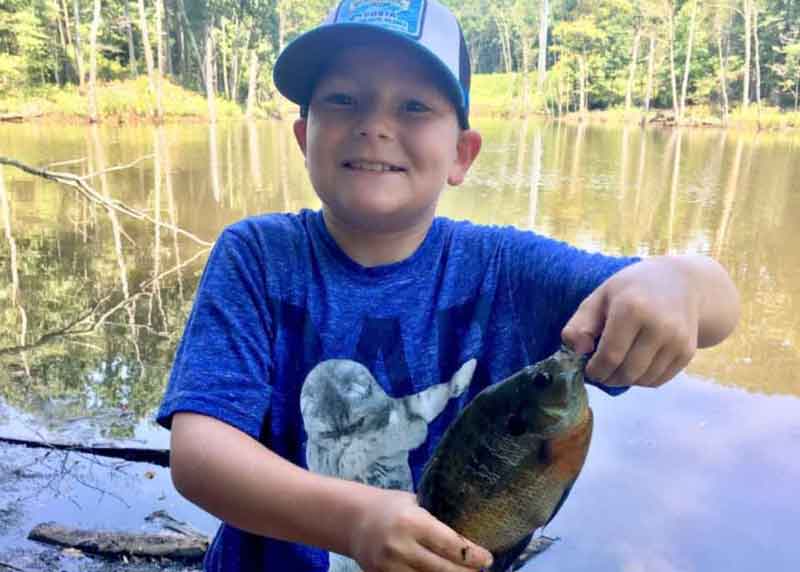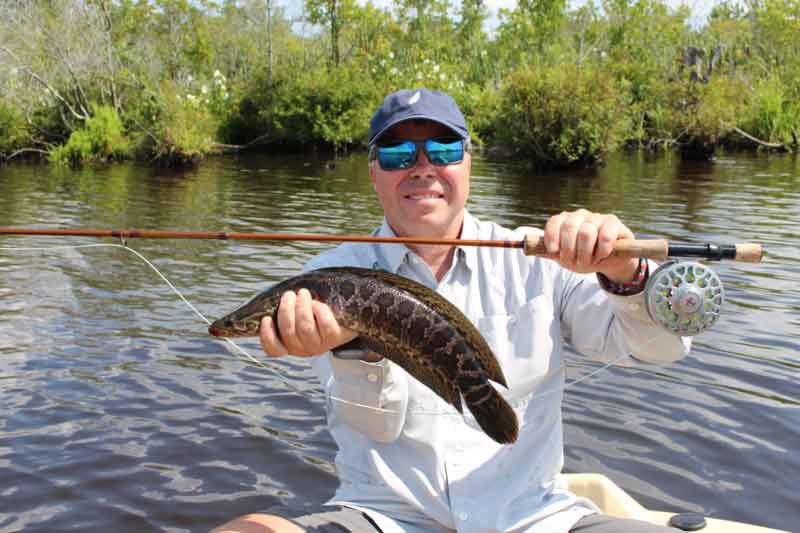When you hear about fly fishing, most people automatically think of rainbow trout. Visions of Norman Maclean and Izaak Walton (though the latter didn't actually fly fish) wading in a scenic stream or river as fish sip hatching flies off the surface of the water. As beautiful as it is, many people are turned off by the steep learning curve required to develop the skills necessary to properly present a fly to a discerning trout. It has kept many people from picking up the art in favor of clunkier, though frequently more lucrative, spin fishing. And yet, there is an incremental step any angler can take to bridge the gap between beginner and Lefty Kreh. The humble panfish, whether it is bluegill, crappie, perch, or rock bass, is the fly fishing equivalent of the bunny slope — though unlike in skiing, even the experts often like to go for some non-stop sunfish action from time to time. They can be found anywhere, are always willing to take a fly and will provide hours of entertainment. Moreover, panfish are rarely spooked by poor presentation, so it’s an opportunity to work on those fundamentals and still catch fish.

In my experience, you can catch more panfish on a pond or lake with a fly than with jigs, lures, and sometimes even bait. The small size of the hook means you don’t have to let the fish take it the same way as fishing a worm under a bobber. Also, because you need to impart the action to the fly, you’ll have better sensitivity when the fish strikes and more than likely will set the hook in the fishes’ lip, not its throat. If you get a bite and miss, you don’t need to check your bait to see if it's still there but can just cast it back out. Additionally, the light weight of the fly allows you to drop into areas like hydrilla and retrieve it cleanly, rather than having to mess with a clump of weeds that many other lures pull up.
Fly fishing for panfish is also a perfect opportunity to introduce kids to the sport. As previously mentioned, it can be challenging to get everything right with the cast and drift of a fly on a stream for trout. Also, patience is an absolute must for trout fishing. Put these together and many little kids would just as soon start skipping stones or dive into the creek than fish. However, fishing for panfish in a pond is much more forgiving and the sustained action will keep the kiddos interested—you could soon have a lifelong angler on your hands.
Basic Gear for Fly Fishing for Panfish
Rods and Reels
Fly fishing for panfish does not require any kind of special gear. That cheap rod and reel combo from the megamart will do just fine. You can fish anything up to about a six-weight rod for panfish and still get a good fight out of them. However, the lighter the setup, the harder the fight. I love using a three-weight when the opportunity presents itself. You also do not need to think too hard about a leader. Panfish aren’t leader shy, so you can use a 3X or 4X mono leader that is 7.5 feet long, and you can add length if you want to fish deeper. There are several setups for the leader that I use based on what types of flies are in order, all of them straightforward and easy to use.
Streamers
During the spring if you cast into a flat filled with perfectly round indents, it will not be long before your line comes tight. Bluegill and crappie will attack just about anything that swims by their nest. One of the things they hate the most? A size eight or 10 black Woolly Bugger that slowly sinks, then gets a little twitch to make it look alive. There is something about the slow sink that gets the fish going. You need the absolute minimum weight to get the fly to sink. A split-shot sinker is already too big. Get flies with a couple wraps of lead wire on the fly to help it sink, but slowly. Other streamers like Zonkers, mini leeches, or Clouser minnows with light dumbell eyes will also trigger strikes. Panfish are rarely picky, as long as the fly has that slow sinking action. The smaller the streamer, the more bites you’re going to get. However, you may have to shake off a mess of smaller fish, so once you get a bunch of fish, change out for the next size up and the quality of fish will get better.

There are two retrieves for streamer fishing that I use: 1) A short, sharp strip with a three second pause, or 2) a longer, but much slower strip. The retrieve you use will depend on how the fish are biting.
Nymphs
For me, nymphs are the most effective flies to fish for panfish. Nymphs can be fished at any depth; whether it is a weightless Green Weenie on a shallow flat, or a big tungsten bead-head Hare's Ear in a deep spillway outflow from a dam. My go-to setup for nymphs is to use two flies—one larger and more flash and one smaller and more natural—fished about 12 to 15 inches apart, depending on your depth. The top fly is something in a bright color like chartreuse or purple. I will generally go with a mini leech in a size 10 or 12. The big fly is designed to catch the fish's attention. If they don’t hit it, chances are good that they’ll prefer the bottom fly, which is always smaller to imitate a natural aquatic insect. My top choices include a Hare's Ear in size 12 or 14, a Prince Nymph, or a Zug Bug, both in size 14.
I fish this rig one of two ways: 1) I put on a strike indicator and slowly strip the line in. This is the easier way to detect a strike, but if you aren't quick to set the hook the fish could quickly spit out the fly. 2) Without an indicator, I cast out, let the fly sink for about three seconds, lift my rod tip slowly, then drop it back down and strip in the slack. I repeat this action until I get a strike or have pulled in all of the fly line. Though it requires a bit more attention, I find the lift works better for setting the hook on an unsuspected bite.
Dry Flies
I saved the best for last. Dry flies are the hardest technique to fish for trout. Even the most skilled fly casters have days where the fly doesn't land right, the leader doesn't roll out perfectly, you don't have the right fly, or any number of other factors that make the fish ignore your offering. Panfish love to eat insects on top of the water, no matter what they are. This is where you get to have the most fun, splatting a foam beetle, ant, or hopper fly on the water, perhaps twitching it once or twice before you see a wake streaking at the fly as a panfish rushes in to absolutely crush it. This is also a great opportunity to practice that delicate presentation of a traditional dry fly like an Adams or a Royal Wulff. You do not have to worry as much about matching the hatch when panfishing. This is a chance to use those unattractive or imperfect flies that no self-respecting trout would go near.

Fishing with dry flies also gives you the chance to fish above and below the surface with a dry-dropper combo. Tie about 12 inches of tippet to the bend of your dry fly, then tie a light nymph to the other end. Fish it just like you would with the indicator technique described above, but now you have a double threat; the dry fly will act as an indicator if a fish takes the nymph, or the fish could hit the dry fly.
Learning the Roll Cast
Early on in my fly fishing career an elder gentleman on the stream taught me the proper technique, as well as the importance, of the roll cast. Most of the ponds I have fished are lined with trees to provide shade and food for fish. The roll cast technique does not use the traditional back-cast ubiquitous to the sport and is used when there is no space behind an angler. Instead, you measure your line before you cast, flip a smaller length of line out onto the water—you’ll use the surface tension to anchor your line—lift your rod tip so that it’s straight up in the air (high noon if you envision the clock image), then slowly and smoothly push your rod forward until it points straight out (nine o’clock), creating a loop or roll in the line that will flip your fly out into the water. I cannot emphasize enough that this should be done slowly and smoothly. If you try to go fast and put power into the roll, your line will not unfurl properly and will land in a heap right in front of you. For a visual demonstration, check out this video:
Okay: now you’re ready to hit your local pond or lake and catch a mess of crappie or bluegill. Who knows where it might lead…?
- By Peter Turcik